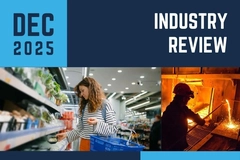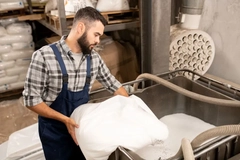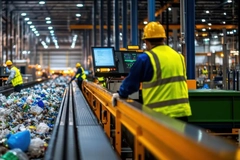Amazon US holiday season consumer survey reveals major interest in sustainable packaging
 Pat Lindner, vice president of Mechatronics and Sustainable Packaging at Amazon (Image credit: Amazon).
Pat Lindner, vice president of Mechatronics and Sustainable Packaging at Amazon (Image credit: Amazon).Amazon consumers in the US are highly conscious of the environmental consequences of their e-commerce packaging this holiday season, as revealed in a new Amazon survey conducted by The Harris Poll. Respondents showed consciousness about recycling, the amount of gift packaging used and willingness to reuse.
“It’s great to see that according to The Harris Poll, 71% of US consumers say they are likely to upcycle materials for gift wrapping this year. We continue to expand our use of paper-based packaging where possible, including using paper filler made from 100% recycled content to replace all plastic air pillows in delivery packaging used at our global fulfillment centers. That paper filler can be easily used as stuffing or wrapping paper,” Pat Lindner, vice president of Mechatronics and Sustainable Packaging at Amazon, tells Packaging Insights.
“It was also interesting to see that many US consumers would be happy to receive deliveries and gifts with minimal or no added packaging because we continue to expand Amazon’s Ship in Product Packaging program, where products are certified to ship safely in their original packaging, with no added Amazon packaging needed. In 2023, we shipped 12% of our orders globally without any additional Amazon packaging.”
Reduce and recycle
Lindner asserts that, globally, Amazon continues to find ways to reduce packaging while making the materials it uses easier to recycle. He highlights some of the company’s notable achievements in this regard.
 Amazon is seeking ways to reduce packaging while making the materials it uses easier to recycle.“In 2023, Amazon avoided more than 446,000 metric tons of packaging. Since 2015, we’ve reduced the average per-shipment packaging weight by 43% and avoided a total of more than 3 million metric tons of packaging — the equivalent weight of nearly 285 of Seattle’s iconic Space Needle.”
Amazon is seeking ways to reduce packaging while making the materials it uses easier to recycle.“In 2023, Amazon avoided more than 446,000 metric tons of packaging. Since 2015, we’ve reduced the average per-shipment packaging weight by 43% and avoided a total of more than 3 million metric tons of packaging — the equivalent weight of nearly 285 of Seattle’s iconic Space Needle.”
“In 2023, we decreased our average plastic packaging weight per shipment by 9% across Amazon’s global operations network, building on a 17% reduction in 2022. Altogether, we’ve avoided 80,500 metric tons of single-use plastic packaging since 2020.”
“In 2023, we shipped 12% of our orders globally without any additional Amazon packaging.”
Addressing potential concerns about product safety and damages associated with Amazon’s decreased use of packaging, Lindner says: “We start with protecting the product to ensure orders will arrive undamaged. From there, we find ways to use less packaging, while prioritizing household recyclable materials.”
“To ensure damage-free deliveries while aiming to use as little packaging as possible, Amazon has designed and built models to determine the most efficient type of packaging for items. Any new packaging change goes through a thorough analysis to meet our high standards.”
“This type of analysis allows us to use envelopes and bags for delivery, which are up to 89% lighter than a similar-sized box. In 2023, in the US, Canada and Europe, 50% of Amazon’s shipments were delivered in these types of lightweight packaging.”
Amazon’s pack innovation
Amazon continues to invest to find solutions reducing packaging, prioritizing “easy-to-recycle” materials while ensuring orders reach customers undamaged.
“Our teams are working hard every day building and testing new innovations. In our efforts to transition to paper packaging, we have retrofitted more than 120 of our automated packing machines that made plastic bags to now create made-to-fit paper bags across the US.”
“We implemented this in more than 20 fulfillment centers, helping us avoid more than 130 million plastic bags this year. Through our testing and learning, we have developed a new generation of this machine. Updates allow for us to pack larger products, helping to increase the number of products that can be packaged in paper bags by 20%.”
 Amazon is prioritizing “easy-to-recycle” materials while ensuring orders reach customers undamaged.Lindner says that new sensors on the machine help measure all dimensions of a product, allowing the company to create more correctly sized packaging, reducing the amount of paper it uses.
Amazon is prioritizing “easy-to-recycle” materials while ensuring orders reach customers undamaged.Lindner says that new sensors on the machine help measure all dimensions of a product, allowing the company to create more correctly sized packaging, reducing the amount of paper it uses.
“We are also testing a newer machine that creates on-demand, household recyclable, made-to-fit packages for products that require more protection than a non-padded bag. This machine measures an order’s dimensions and then creates a right-sized, protective package using a type of corrugate that is flexible and lighter than the typical box.”
The made-to-fit technology, paired with the lighter corrugate, allows these machines to reduce waste by minimizing the amount of material we ship per package while providing the customer with an easy-to-open experience.
“Our focus is always on the customer. We want to ensure our packaging allows the product to arrive safely, and from there, we want to reduce the amount of packaging they receive and make it easy for them to recycle that packaging,” Lindner concludes.










